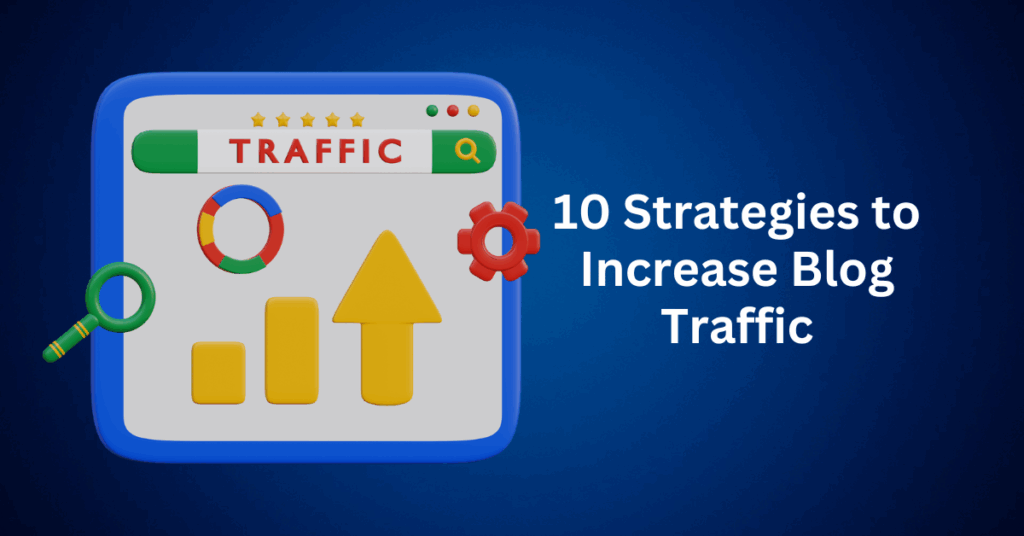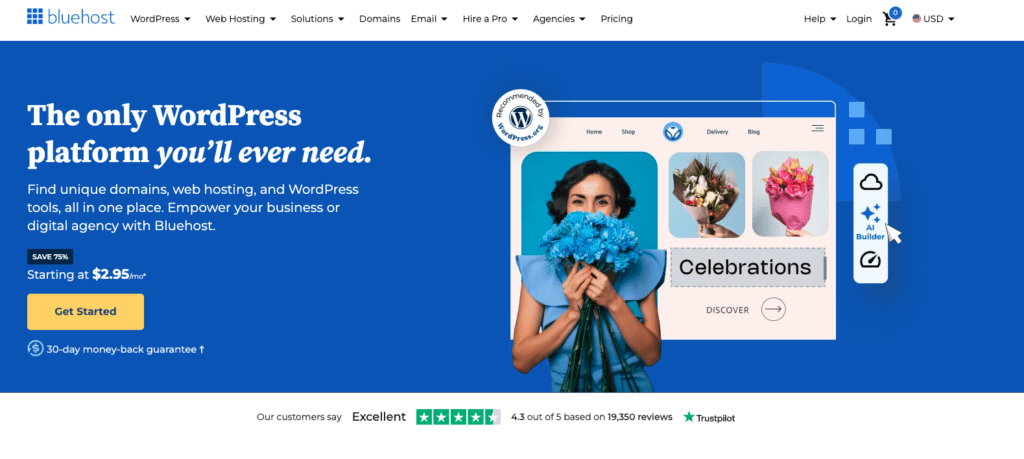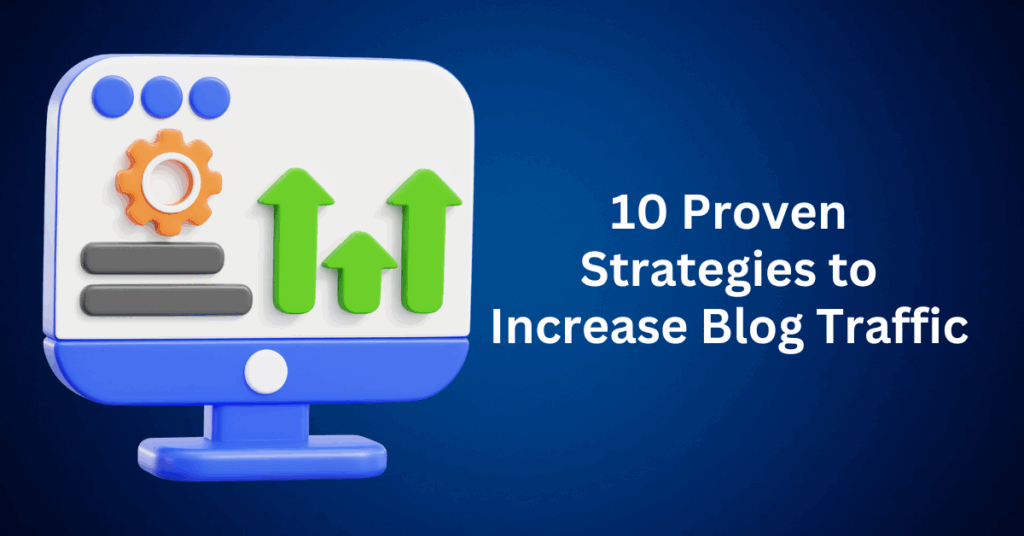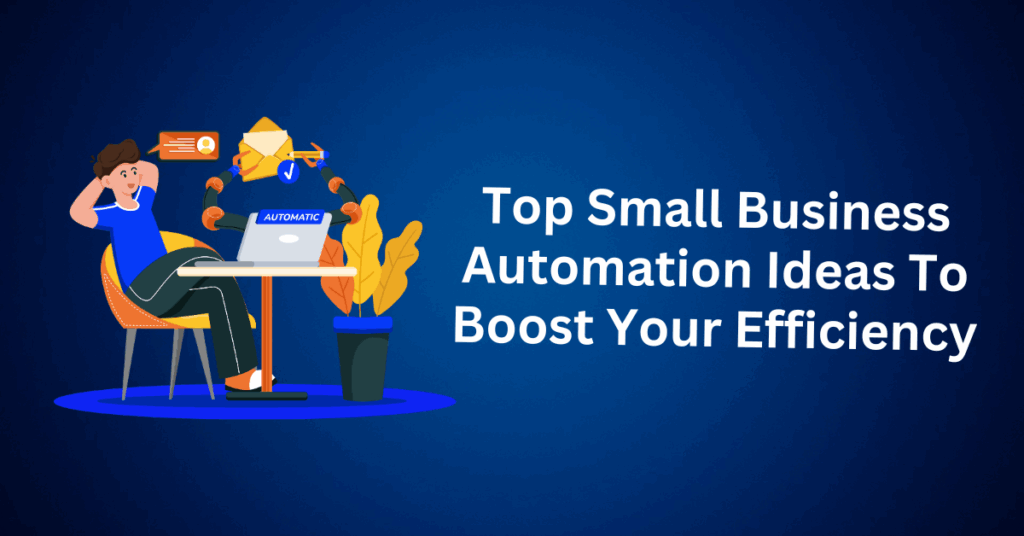If you’re a blogger, you’ve probably asked yourself this at some point: How do I get more traffic to my blog? You’re not alone and the answer isn’t some hidden hack or overnight trick. Growing blog traffic is all about using smart, sustainable strategies rooted in consistency, data, and connection with your audience.
When I launched my first blog, I believed great content would naturally attract readers. I quickly learned that while quality writing is essential, it’s only one piece of the puzzle. Over time, I experimented with SEO techniques, started sharing content more strategically on social media, built backlinks, and paid close attention to analytics. The results didn’t happen overnight, but they were lasting and that’s what really matters.
Building long-term blog traffic is more achievable than ever now. Whether you’re starting from scratch or looking to breathe life back into an existing site, this comprehensive guide will walk you through 10 data-backed strategies that go beyond the basics. We’ll cover SEO, content promotion, audience engagement, backlink building, analytics, and more, so you can stop guessing and start growing.
Understanding Blog Traffic: Organic vs. Paid (And Why It Matters)
Before diving into specific growth tactics, it’s essential to understand where your traffic is coming from and how to use that knowledge to your advantage.
Most blog traffic falls into two categories: organic and paid.
Here’s a quick breakdown to help you understand the key differences:
| Feature | Organic Traffic | Paid Traffic |
| Cost | Free (but time- and effort-intensive) | Requires ad budget (e.g., Google Ads, Meta) |
| Time to See Results | Gradual growth with consistency | Immediate, once campaigns go live |
| Sustainability | Long-lasting with proper SEO/content strategy | Ends when you stop paying for ads |
| Trustworthiness | High: users trust content they find naturally | Lower: seen as promotional or sales-focused |
| Click-Through Rate | Typically higher with strong search rankings | Often lower due to ad fatigue or skepticism |
| ROI Potential | Higher in the long run with solid strategy | Varies depends on targeting and execution |
| Skills Needed | SEO, content planning, audience engagement | Ad management, copywriting, funnel strategy |
While both traffic types have value, organic traffic tends to offer more sustainable, long-term results, especially for bloggers aiming to grow authority and visibility without a massive advertising budget.
10 Strategies to Increase Blog Traffic
If you’re searching for practical, sustainable ways to boost your blog traffic without relying solely on ads, you’re in the right place. These 10 strategies are designed to help you attract consistent, high-quality visitors using free or low-cost tools and methods that actually work.

Let’s break down each strategy with real-world examples and expert tips you can implement today.
1. Master SEO to Rank Higher and Get More Blog Traffic
Search Engine Optimization (SEO) remains one of the most powerful traffic sources for bloggers. But modern SEO is no longer just about cramming in keywords. Instead, it’s about understanding search intent and offering true value.
How to do it effectively:
- Use keyword research tools like Ahrefs, Ubersuggest, SEMrush, or the free version of Yoast SEO to find keywords with solid traffic potential.
- Craft optimized meta titles and meta descriptions that entice users to click on your posts in search results.
- Organize your content using H1, H2, and H3 tags for improved readability and SEO structure.
- Link internally to other related blog content to increase time on site and reduce bounce rates.
- Add outbound links to reputable websites that support or expand your ideas.
- Use a plugin like Yoast SEO if you’re on WordPress. If you’re hosting with Bluehost, the plugin comes pre-installed and ready to help you optimize posts with real-time feedback and on-page SEO scoring.
Pro Tip: Google’s algorithm now prioritizes content that directly addresses user needs. Don’t just target a keyword, solve a problem.
2. Tap Into Blogging and Niche Communities to Get More Blog Traffic
Online communities can be goldmines for referral traffic, especially when you participate genuinely. By joining groups where your audience already hangs out, you can build trust, authority, and visibility.
Places to join:
- Reddit communities like r/Blogging, r/Entrepreneur, or topic-specific subreddits
- Facebook Groups focused on blogging, SEO, or niche industries
- Slack and Discord servers for creators, marketers, and developers
Pro Tip: Focus on adding value before sharing links. Answer questions, give advice, and only share blog content when it’s truly helpful. This builds long-term credibility.
3. Promote Blog Posts on Social Media (Strategically) to Get More Traffic
Social media is a fast, free way to amplify your blog’s reach and introduce your content to new audiences. However, it’s not enough to just drop a link. You need to engage.
How to drive social traffic:
- Turn blog posts into bite-sized content: Create Instagram carousels, TikTok videos, Pinterest pins, or LinkedIn slideshows.
- Share your posts across multiple platforms like Facebook, Instagram, X (formerly Twitter), Pinterest, LinkedIn, and Threads.
- Use platform-specific strategies, like hashtags on Instagram or polls on LinkedIn, to increase engagement.
Pro Tip: Create a Facebook Page or Group for your blog. Not only does it help build a tight-knit community, but you can also promote new blog posts directly to your most engaged readers.
4. Use Email Marketing to Retain and Grow Your Audience
While social media platforms can change their algorithms overnight, your email list is yours to keep. That’s why email remains one of the most reliable traffic drivers.
How to grow and use your list:
- Offer a freebie (e.g., eBook, checklist, cheat sheet) to entice signups.
- Send weekly or monthly newsletters with your latest blog content, updates, and exclusive tips.
- Use email segmentation to send tailored content to specific groups within your audience.
Bonus Tip: Bluehost offers tools like Professional Email and Creative Mail, which integrate directly into WordPress. These tools simplify email marketing setup and allow you to manage campaigns without leaving your dashboard.
Pro Tip: Use platforms like ConvertKit, Mailchimp, or Moosend for advanced email automation, lead tagging, and analytics.
5. Collaborate with Influencers, Bloggers, and Guest Post
Guest blogging is far from obsolete. It’s more strategic than ever. By partnering with influencers or other bloggers in your niche, you can tap into new audiences and boost your blog’s authority.
What you can do:
- Reach out to other bloggers in your niche for guest post opportunities. Guest blogging introduces your blog to new readers while establishing your authority.
- Interview micro-influencers or niche experts and share their insights on your blog. These collaborations often lead to social shares and backlinks.
- Join roundup posts where several bloggers contribute their expertise to a single post. This can lead to valuable backlinks and traffic from their audience.
- Collaborate on co-branded content, such as guides, courses, or webinars, which helps both parties gain exposure.
- Set up an affiliate program to incentivize others to promote your blog in exchange for a commission. Tools like the YITH WooCommerce Affiliates plugin allow you to manage and track affiliate partners, making collaborations seamless.
Pro Tip: When pitching guest posts, focus on linking to high-converting landing pages or lead magnets that encourage visitors to join your email list or explore more content.
6. Utilize Internal Linking for Better User Experience and SEO
Internal linking is one of the most overlooked yet powerful strategies for increasing blog traffic. Linking to your own content helps search engines understand your site structure, boosts SEO, and keeps readers engaged by guiding them to more valuable articles.
Why it matters:
- Improves crawlability: Search engines can crawl your blog more efficiently when it’s well-linked internally.
- Increases page views: Internal links guide users to more relevant posts, increasing the time they spend on your site.
- Enhances user experience (UX): Offering related articles helps visitors find more content they’re interested in, reducing bounce rates.
Pro Tip: Add a “Related Posts” section at the end of your articles, or link older blog posts within new content. This ensures that visitors keep exploring your site and boosts engagement.
7. Implement Long-Tail Keywords to Capture Targeted Traffic
Long-tail keywords are your best friend when it comes to ranking for less competitive search queries. Long-tail keywords are especially important if you’re just starting out or if your blog is in a highly competitive niche. These keywords often have lower search volume but higher conversion potential because they address specific user intent.
How to find long-tail keywords:
- Use tools like Google AdWords Keyword Planner, SEMrush, Ahrefs, or Moz to find keywords with longer phrases that are relevant to your niche.
- Examples:
- Instead of targeting broad keywords like “blog traffic,” try something more specific, like “how to increase blog traffic in 2025.”
- Instead of just “SEO,” target more niche phrases like “using SEO to drive visitors to your blog without paid ads.”
Pro Tip: Use tools like Google Autocomplete and AnswerThePublic to uncover long-tail keyword ideas that are often overlooked but have real traffic potential.
8. Improve User Experience (UX) to Keep Readers Coming Back
A smooth, intuitive blog layout not only enhances user satisfaction but also positively impacts your SEO rankings. Google values sites that offer a great user experience because it leads to higher engagement and better retention.
Quick wins to improve UX:
- Ensure mobile-friendliness: With the majority of web traffic coming from mobile devices, it’s crucial that your blog is responsive and looks great on all screen sizes.
- Boost page load speed: A slow site leads to higher bounce rates and can harm your SEO. Use tools like Google PageSpeed Insights to identify performance bottlenecks.
- Design clean, minimalist layouts: Avoid clutter and use large, legible fonts to enhance readability. Your readers should be able to easily navigate your content without distractions.
- Avoid intrusive pop-ups: While pop-ups can be effective for lead generation, they can also disrupt the reading experience. Use them sparingly, and make sure they don’t interfere with content consumption.
Pro Tip: Regularly check your blog’s performance with tools like GTmetrix to ensure a fast, smooth experience for your readers.
9. Repurpose Content Across Multiple Channels
Creating high-quality blog posts takes time, so why not maximize its potential? Repurposing your content allows you to reach wider audiences, drive more traffic, and gain visibility on platforms where your blog may not otherwise be discovered.
Ways to repurpose content:
- Turn a blog post into an Instagram carousel that highlights key points.
- Create a YouTube tutorial that dives deeper into the topic.
- Rewrite your blog post as a LinkedIn article for a professional audience.
- Design a Pinterest infographic that captures the main ideas visually.
- Record a podcast episode discussing the content, offering a more personal touch.
Pro Tip: Repurposing your blog posts into multiple formats allows you to reach new audiences while putting less effort into creating entirely new content from scratch.
10. Monitor Traffic with Analytics Tools
Tracking and analyzing your blog’s performance is essential to understanding what’s working and what needs improvement. By regularly reviewing your traffic data, you can identify trends, measure success, and refine your content strategy to drive better results.
Essential analytics tools:
- Google Analytics: This tool provides deep insights into where your traffic comes from, which pages perform best, and user behavior on your site.
- Google Search Console: Helps you track your rankings, monitor site performance, and resolve indexing issues.
- Microsoft Clarity or Hotjar: These tools give you heatmaps and session recordings to visualize user behavior, so you can make data-driven decisions on UX improvements.
Pro Tip: Set up goals and funnels in your analytics tools to measure traffic conversion, helping you tie blog traffic metrics directly to user actions like sign-ups or purchases.
With these 10 actionable strategies, you’re equipped to increase your blog traffic. Whether you’re a new blogger or looking to breathe new life into an existing site, the key to success lies in consistent, data-driven efforts and a strong commitment to providing value to your audience.
How Bluehost Can Supercharge Your Blog Traffic
If you’re serious about scaling your blog, your hosting provider should be more than just a place to park your domain. It should be an integral partner in your traffic growth strategy. That’s where Bluehost steps in.
Recommended by WordPress since 2005, Bluehost goes beyond basic hosting by providing bloggers with powerful SEO tools, digital marketing services, and expert support, everything you need to attract more visitors and grow your blog faster.
Here’s how Bluehost helps you level up your blog traffic:
1. Start Smart with Bluehost WordPress Hosting
Whether you’re launching a new blog or looking to scale an existing one, Bluehost’s WordPress hosting plans are designed to ensure you succeed from day one. With three flexible plans, Basic, Choice Plus, and eCommerce Premium, Bluehost offers the tools and support needed to hit the ground running.

What’s included with Bluehost WordPress hosting:
- Free domain for the first year to get you started without extra costs.
- WordPress pre-installed with automatic updates to save you time.
- AI Site Creation tools through Bluehost WonderSuite to help you quickly set up a beautiful, functional site.
- Free CDN (Content Delivery Network) with Argo Routing for faster global performance.
- Free SSL certificate for secure connections and enhanced trust.
- Malware scanning and Firewall protection to keep your blog secure.
- Static & Object Caching for optimized load times, reducing bounce rates and improving user experience.
- Access to a WordPress staging site to test new ideas before going live.
- 24/7 support via live chat, ensuring you have help when you need it most.
With Bluehost, you’re not just getting hosting. Instead, you’re getting a full-service platform that’s built for growth, speed, and security.
2. Use Bluehost’s Free SEO Checker Tool
If you’re using SEO to drive visitors to your blog, understanding why your blog isn’t ranking well is the first step to improving your strategy. Bluehost’s Free SEO Checker tool acts as your personal SEO audit assistant, helping you uncover critical issues and optimize your blog for better visibility.
What Bluehost’s Free SEO Checker does:
- Analyze technical SEO issues like slow load times, broken links, and missing tags.
- Identify missing meta descriptions and title tags, which are crucial for click-through rates.
- Spot mobile usability issues, ensuring your blog performs well across devices.
- Track keyword performance and identify gaps in your content strategy.
- Audit your website’s current SEO health to understand where you stand.
- Get personalized SEO recommendations for each blog post, helping you optimize content for better search engine rankings.
Pro Tip: No need for third-party tools. Bluehost’s SEO Checker gives you everything you need to boost your blog’s organic traffic directly from your dashboard.
3. Invest in Digital Marketing with Bluehost Professional Services
Want to focus on writing great content while experts handle your promotion? Bluehost Professional Marketing Services make it easy to scale your blog without becoming a digital marketing expert yourself.
Here’s what you get with Bluehost’s all-in-one digital marketing service:
- SEO optimization to improve rankings and drive organic traffic.
- PPC (Pay-Per-Click) management via Google Ads, providing you with an immediate boost in traffic.
- Social media marketing strategies to build your online presence and engage with your audience.
- Content strategy consultation to help plan and promote your blog posts effectively.
- Email marketing setup using Creative Mail, a platform designed to engage your audience and keep them coming back for more.
Perfect for bloggers who are ready to scale but don’t have time to learn all the ins and outs of digital marketing.
4. Leverage Built-in Intelligence & Support
With Bluehost, you’re never on your own. From AI-powered onboarding that helps set up your blog in minutes to free expert-led classes, Bluehost provides both the tools and guidance you need to master blog traffic growth.
Whether you’re looking for organic growth, faster website performance, or expert promotion, Bluehost gives you the resources to build traffic and authority, all from a single, easy-to-use dashboard.
Pro Tip: Take advantage of Bluehost’s 24/7 live chat support for any questions or troubleshooting you may need as you scale your blog.
Free Blog Traffic vs. Paid Ads: Which Builds Authority Faster?
When it comes to increasing blog traffic, there’s an ongoing debate between organic (free) traffic and paid traffic. Both have their pros and cons, but they serve different purposes.
- Free (Organic) Traffic: This includes traffic from SEO, social media, and referrals. While it takes time to build, organic traffic fosters trust, engagement, and domain authority. It’s a long-term investment that pays off by creating a sustainable audience base.
- Paid Traffic: Paid ads (Google Ads, Facebook Ads, etc.) provide instant visibility but come at a cost. Once you stop running the ads, the traffic disappears. Paid ads are great for short-term results and scaling efforts, but they shouldn’t replace a solid organic traffic strategy.
The most effective approach is to first focus on building organic traffic through SEO, content marketing, and guest posts. Once you’ve established a strong foundation, paid ads can be a useful tool for scaling and boosting visibility.
Business Benefits of High Blog Traffic
Blog traffic is more than just a vanity metric. It directly influences your bottom line. Consistently driving targeted traffic to your blog offers a range of business benefits, from increasing your brand’s visibility to generating revenue.
1. Building Trust and Authority
When your blog ranks on the first page of Google and gains traction across social media, it positions your brand as a trusted resource in your industry. Consistent visibility and shareability help establish your blog as an authoritative voice within your niche. Over time, this authority attracts quality backlinks from reputable websites, encourages deeper reader engagement, and drives more repeat visits. As a result, your overall SEO performance improves significantly. Building credibility through authority doesn’t just enhance your reputation, it also boosts your ability to convert readers into loyal customers by fostering trust at every stage of the buyer’s journey.
2. Lead Generation
Increased blog traffic opens the door to more lead-generation opportunities. Each new visitor represents a potential subscriber, customer, or long-term follower. By offering email sign-ups, downloadable resources, or free trials, you can turn that traffic into a growing email list and begin nurturing meaningful relationships. To effectively convert readers into leads, consider offering gated content such as eBooks or reports, using persuasive calls to action throughout your posts, and strategically placing pop-ups or slide-ins that capture attention without disrupting the user experience. When you pair consistent blog traffic with well-crafted email marketing campaigns, you create a self-sustaining funnel that continuously generates and nurtures new leads.
3. Enhanced Brand Visibility
Every visit to your blog is a valuable opportunity for your brand to gain exposure. A blog that consistently attracts substantial traffic not only boosts your visibility in search engine results but also catches the attention of influencers, industry leaders, and potential collaborators. This heightened visibility can lead to invitations for guest blogging, podcast features, or media mentions, further expanding your reach. As your content spreads across various platforms and appears more frequently online, your brand becomes increasingly recognizable, respected, and positioned as a leader within your industry.
Why Your Blog Isn’t Getting Traffic (And How to Fix It)
If you’ve been writing quality content for your blog but aren’t seeing the traffic you expect, it can be incredibly frustrating. You may be doing everything right, but hidden roadblocks could be preventing your blog from reaching its full potential. Let’s break down the common reasons why your blog might not be getting the traffic it deserves and more importantly, how to fix them.

1. Mobile Optimization Is Crucial
Today, more than 60% of web traffic comes from mobile devices, and with Google’s mobile-first indexing, having a mobile-friendly website is no longer optional, it’s essential. If your blog isn’t optimized for mobile, you’re likely losing a significant portion of potential readers. Slow loading times, difficult navigation, or a clunky design on smartphones can cause visitors to bounce before they even engage with your content.
To avoid this, make sure your blog is fully mobile-responsive. Start by choosing a mobile-friendly WordPress theme and running your site through Google’s Mobile-Friendly Test. Next, improve performance by using caching and compression tools like WP Rocket or W3 Total Cache, and be sure to optimize all images for faster loading on mobile devices.
Finally, pay close attention to the user experience on smaller screens. Ensure that buttons are easy to tap, text is readable without zooming, and navigation is intuitive. Remember, mobile optimization isn’t just a technical requirement, it’s often your blog’s first impression. Make it count.
2. SEO Optimization Is Key to Discoverability
While creating great content is important, SEO optimization ensures that your content ranks in search engines and reaches your target audience. Without SEO, even the best blog posts won’t get the visibility they deserve. Optimizing your blog for search engines helps you attract organic traffic, improves your rankings, and boosts long-term authority.
If you’re not doing keyword research before writing, forgetting to include target keywords in titles, or overlooking important elements like meta descriptions and image alt text, you may be missing out on crucial SEO opportunities.
You can use SEO plugins like Yoast or Rank Math to help guide your on-page optimization. Research long-tail keywords that your audience is actually searching for, and structure your content using proper headings (H1, H2, H3). Regularly update older blog posts with new data and keywords, and monitor your performance through Google Search Console. With solid SEO practices, your blog will stand out in search results and attract consistent, organic traffic.
3. Promotion Is Key to Gaining Traffic
Even great content needs a push to get noticed. Without actively promoting your blog posts, you’re limiting your blog’s reach. Promotion not only drives more traffic but also helps you grow your email list and build authority in your niche.
If you aren’t promoting your content across social media platforms or repurposing posts into different formats (like videos, infographics, or emails), you’re missing valuable opportunities to increase visibility. Similarly, if you don’t have lead magnets to encourage email sign-ups, your blog’s growth will stagnate.
You can create lead magnets such as eBooks, checklists, or downloadable resources to capture emails. Use social media and relevant online communities to promote your blog posts, and repurpose your content into different formats (like YouTube videos, infographics, or carousel posts). Investing in Google Ads or collaborating with influencers can also help spread the word about your blog.
4. Engage with Your Audience to Build Community
Blogging isn’t just about writing content. In fact, it’s about building relationships. If you’re not interacting with your audience, you’re missing out on creating a loyal community that’s more likely to return and share your content. Engaging with readers helps improve trust, credibility, and encourages user interaction, which can have a positive impact on your SEO rankings.
If you don’t reply to comments, emails, or direct messages, or if your email newsletters are purely broadcast with no interaction, you’re neglecting one of the most crucial aspects of blogging: community building. Ignoring engagement also means you miss valuable feedback from your readers, which can lead to better content ideas.
You need to make a habit of responding to comments on your blog and social media. Ask readers for their input or topic suggestions, and participate in niche-specific forums or Facebook groups. Include calls to action (CTAs) in your blog posts to encourage interaction and share your content on social media to engage directly with your followers.
5. Consistency Is Essential for Growth
Blogging is a long-term game, and consistency is what separates thriving blogs from stagnant ones. If you’re not regularly publishing new content, it becomes difficult to build momentum or keep your audience engaged. Frequent posting not only shows readers that your blog is active, but it also signals to Google that your site is worth indexing. Plus, more content means more chances to rank for a wider range of keywords, earn backlinks, and get shared on social media, all of which boost your SEO.
On the other hand, if you haven’t published in months or your posts go live sporadically with no clear schedule, your blog’s growth is likely to stall. It’s easy to lose motivation when traffic doesn’t pick up immediately, but it’s important to remember: consistency is the foundation of long-term success.
To stay on track, create an editorial calendar that maps out your content in advance. Start simple, aim to publish one post per week, and scale up as you become more comfortable. Along the way, use tools like Google Analytics to track performance, monitor progress, and stay focused on your blogging goals.
Final Thoughts: 10 Proven Strategies to Increase Blog Traffic
Increasing blog traffic requires more than just hitting “publish.” To truly grow your audience, you need consistency, a smart strategy, and the right tools. In other words, it’s essential to think about the full picture, SEO, community building, user experience, and content promotion across various channels. Fortunately, every blog post you create is an opportunity to attract, engage, and convert more readers.
To succeed, you must focus not only on creating high-quality content but also on building a robust system to support long-term growth. This means diving into keyword research, launching targeted email campaigns, tracking performance, and developing a strong social media strategy.
That’s where Bluehost comes in. As a trusted platform powering millions of WordPress websites, Bluehost provides everything you need to grow your blog. From built-in SEO tools and lightning-fast hosting to free domains and expert marketing support, Bluehost is designed to help you succeed. Whether you’re just starting out or looking to optimize an existing blog, Bluehost can help you attract more readers, boost your rankings, and expand your online presence.
So why wait? Start your blog or take it to the next level with Bluehost today.


